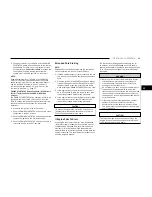
Battery Blanket Usage
A battery loses 60% of its cranking power as the battery
temperature decreases to 0°F (-18°C). For the same
decrease in temperature, the engine requires twice as
much power to crank at the same RPM. The use of
120 Volt AC powered battery blankets will greatly
increase starting capability at low temperatures. Suit-
able battery blankets are available from an authorized
Mopar® dealer.
Engine Warm-Up
Avoid full throttle operation when the engine is cold.
When starting a cold engine, bring the engine up to
operating speed slowly to allow the oil pressure to stabi-
lize as the engine warms up.
NOTE:
High-speed, no-load running of a cold engine can result
in excessive white smoke and poor engine perfor-
mance. No-load engine speeds should be kept under
1,000 RPM during the warm-up period, especially in
cold ambient temperature conditions.
Your vehicle is equipped with an engine warm-up pro-
tection feature that may limit engine performance after
cold starting at low ambient temperatures. The length
of time engine speed is limited is dependent upon
engine coolant temperature. Engine speed may be
briefly limited to 1,000 RPM after starting with coolant
temperature below freezing conditions, and may be
limited to 1,000 RPM for up to approximately two min-
utes under more severe cold conditions.
NOTE:
If ambient temperatures are low and the coolant tem-
perature is below 180°F (82°C), the engine idle speed
will slowly increase to 1,000 RPM after two minutes of
idle, if the following conditions are met:
•
Foot is off brake pedal and accelerator pedal.
•
Automatic transmission is in PARK.
•
Vehicle speed is 0 mph (0 km/h).
•
Applying the accelerator pedal will cancel fast idle.
•
Operating the exhaust brake at idle will greatly
improve warm-up rate and will help keep the engine
close to operating temperature during extended idle.
ENGINE IDLING
Avoid prolonged idling. Long periods of idling may be
harmful to your engine because combustion chamber
temperatures can drop so low that the fuel may not
burn completely. Incomplete combustion allows carbon
and varnish to form on piston rings, engine valves, and
injector nozzles. Also, the unburned fuel can enter the
crankcase, diluting the oil and causing rapid wear to
the engine.
If the engine is allowed to idle or the truck is driven on
low engine speed drive cycles for more than two hours,
the system will automatically enter an emissions oper-
ating mode that will increase the engine idle speed to
900 RPM (1,050 RPM for Chassis Cab). While in this
mode, which is designed to help maintain the Diesel
Particulate Filter, the engine idle speed will return to
normal when the brake pedal is applied. A small
change in engine tone or a slight change in engine per-
formance while accelerating may also be noticeable at
speeds below 20 mph (32 km/h). This operating mode
may last for up to an hour of idle time, or around
20 minutes of driving time.
Your truck may have been ordered with an optional volt-
age monitoring idle up feature. If a load is placed on the
electrical system while the truck is in PARK, this feature
will attempt to maintain normal system voltage by auto-
matically increasing engine idle speed. You may notice
several consecutive increases in idle speed, up to a
maximum of 1,450 RPM, as the system will attempt to
utilize the smallest increase in idle speed necessary to
maintain normal system voltage. The idle speed will
return to normal when either the electrical load is
removed, or when the brake pedal is applied.
NOTE:
For instrument cluster display messages related to the
vehicle's exhaust system
Idle-Up Feature
The driver-controlled high idle speed feature will help
increase cylinder temperatures and provide additional
cab heat, however, excessive idling may still cause the
exhaust after-treatment system to not properly regener-
ate. Extended periods of idle time should be avoided.
The Idle-Up feature uses the Cruise Control buttons to
increase engine idle speed and quickly warm the vehi-
cle's interior.
1. With the transmission in PARK, the parking brake
applied, and the engine running, turn on the Cruise
Control, then push the SET (-) button.
2. The engine RPM will go up to 1,100 RPM. To
increase the RPM, push and hold the RES (+) button
and the idle speed will increase to approximately
1,500 RPM. To decrease the RPM, push and hold
the SET (-) button and the idle speed will decrease
to approximately 1,100 RPM.
3. To cancel the Idle–Up feature, either push the CAN-
CEL button, push the ON/OFF button, or press the
brake pedal.
STARTING AND OPERATING
105
4
Summary of Contents for CHASSIS CAB 2024
Page 69: ...GETTING TO KNOW YOUR INSTRUMENT PANEL MIDLINE INSTRUMENT CLUSTER GASOLINE 67 3...
Page 71: ...HIGHLINE INSTRUMENT CLUSTER GASOLINE GETTING TO KNOW YOUR INSTRUMENT PANEL 69 3...
Page 75: ...MIDLINE INSTRUMENT CLUSTER DIESEL GETTING TO KNOW YOUR INSTRUMENT PANEL 73 3...
Page 77: ...HIGHLINE INSTRUMENT CLUSTER DIESEL GETTING TO KNOW YOUR INSTRUMENT PANEL 75 3...
Page 357: ......
Page 358: ......


































